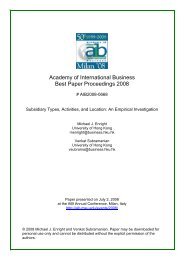AIB 2012 Conference Proceedings - Academy of International ...
AIB 2012 Conference Proceedings - Academy of International ...
AIB 2012 Conference Proceedings - Academy of International ...
You also want an ePaper? Increase the reach of your titles
YUMPU automatically turns print PDFs into web optimized ePapers that Google loves.
TUESDAY<br />
How Does Structural Position Impact Subsidiaries' Knowledge Development and Reverse Knowledge Transfer<br />
Zhaleh Najafi Tavani, University <strong>of</strong> Leeds<br />
Rudolf Sinkovics, University <strong>of</strong> Manchester<br />
Tamer Cavusgil, Georgia State University<br />
Employing the well established dimensions <strong>of</strong> external embeddedness and subsidiary-parent firm<br />
embeddedness, a four quadrant framework <strong>of</strong> subsidiary structural position, Partner, Fencesitter, Receptive, and<br />
Detached subsidiaries, was developed. Variation within the four groups <strong>of</strong> subsidiaries is then analysed in terms<br />
<strong>of</strong> knowledge development and reverse knowledge transfer. Results from 184 subsidiaries operating in<br />
Knowledge Intensive Business Service (KIBS) sectors in the United Kingdom indicate significant inter-group<br />
differences in terms <strong>of</strong> knowledge development and reverse knowledge transfer. Moreover, the empirical data<br />
show that, while high degree <strong>of</strong> external embeddedness is the pivotal element <strong>of</strong> subsidiary knowledge<br />
development, high level <strong>of</strong> subsidiary-parent firm embeddedness is the main determinant <strong>of</strong> reverse knowledge<br />
transfer. (For more information, please contact: Zhaleh Najafi Tavani, University <strong>of</strong> Leeds, United Kingdom:<br />
z.najafitavani@leeds.ac.uk)<br />
Knowledge Co-Creation across National Boundaries: Trends and Firms' Strategies<br />
Wan-Ting Su, National Tsing Hua University<br />
Bou-Wen Lin, National Tsing Hua University<br />
In the era <strong>of</strong> global knowledge economy, knowledge creation has noticeably thrived across the national<br />
boundaries; it plays an increasingly important role in the open innovation paradigm. What are patterns and<br />
characteristics <strong>of</strong> knowledge that is co-created across national boundaries How is it different from knowledge<br />
created within the border How is co-created knowledge used by companies How is internationalization related<br />
to firms' strategies <strong>of</strong> knowledge co-creation In spite <strong>of</strong> their central importance to the theory and practice <strong>of</strong><br />
knowledge management, these questions have not been discussed. Our paper identifies a patent whose<br />
initiative owners are from different countries as an indicator <strong>of</strong> knowledge co-created across national boundaries<br />
and shows the trends <strong>of</strong> cross-border knowledge by using the longitudinal patent data analysis over 30 years.<br />
Our results show that knowledge co-created across borders displays higher value and there exists heterogeneity<br />
<strong>of</strong> knowledge co-creation patterns in Triad regions. In order to enter global markets, to discern trends in local<br />
markets, to tap into the local knowledge and to access further sources <strong>of</strong> new technology, firms can use<br />
mechanisms for co-creating knowledge with local firms. (For more information, please contact: Wan-Ting Su,<br />
National Tsing Hua University, Taiwan: szlin0831@gmail.com)<br />
TMT Identification, Knowledge Creation, and <strong>International</strong> Joint Venture Performance: Does National Diversity<br />
Matter<br />
Bi-Juan Zhong, Ohio State University<br />
Yaping Gong, Hong Kong University <strong>of</strong> Science and Technology<br />
Oded Shenkar, Ohio State University<br />
Yadong Luo, University <strong>of</strong> Miami<br />
The literature about the role <strong>of</strong> organizational identification on knowledge creation in teams has mixed findings.<br />
This study proposes that team national diversity constitutes an important condition to curtail the potential<br />
drawbacks <strong>of</strong> a team's superordinate identification. We proposed that knowledge creation potential in<br />
multinational teams will be best achieved when national diversity and superordinate identification are<br />
acknowledged and promoted simultaneously. Using data from 185 top management teams <strong>of</strong> international joint<br />
ventures (IJVs), we found our model supported. TMT IJV identification was positively related to IJV<br />
performance via increased knowledge creation and this benefit was realized only when TMT national diversity<br />
was high. (For more information, please contact: Bi-Juan Zhong, Ohio State University, USA:<br />
zhong_40@fisher.osu.edu)<br />
<strong>AIB</strong> <strong>2012</strong> <strong>Conference</strong> <strong>Proceedings</strong><br />
Page 191

















